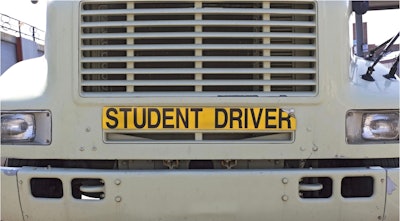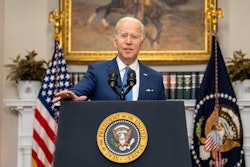
The following is the second part of a multi-part series that addresses the issues surrounding attracting younger drivers. The first part of the series, focused on attracting students to the industry ahead of high school graduation, can be found here. The final piece of the series will include input from experts on how trucking companies can use technology to attract younger generations to a career in trucking.
Shuie Yankelewitz said he can feel the steering wheel of his new car pulling him back to the center of the lane if he accidentally veers off.
That – along with things like active braking, collision mitigation systems and dash cameras – is the type of technology more and more motor carriers are implementing in their trucks to improve driver safety. And it’s what many insurance providers are requiring in order to insure certain drivers like those under 21 years of age.
The U.S. Department of Transportation’s Federal Motor Carrier Safety Administration (FMCSA) is working on a pilot program to allow 18-, 19- and 20-year-old drivers to operate commercial motor vehicles in interstate commerce, creating regulatory pathways for the conversation about insuring those drivers to come up. The pilot is part of larger efforts to close the gap between new drivers and aging drivers that are leaving the trucking industry faster than they can be replaced, creating a severe driver shortage in the U.S. that is having a significant impact on the economy.
With a shortage of more than 80,000 drivers that is expected to continue to grow rapidly, trucking companies are looking to regulatory changes – making the driver interstate driver age 18 rather than 21 – to help bridge that gap.
But a major roadblock stands in the way: insurance.
And Yankelewitz, chief operating officer of Central Analysis Bureau (CAB), said that regulatory change isn’t likely to be very effective in reducing the driver shortage.
“There will be very few to be insured. I don't think there's a chance that it makes enough of an impact because we're talking about a handful of drivers. In the absence of a real insurance program to underwrite it, you're not going to see widespread adoption other than with the bigger carriers who have their own self-insured retention so they don't need to rely on that primary insurer,” he said. “Technology does help … There's no question about it. But at the end of the day, until you're dealing with a 100% autonomous vehicle, there's still a driver who's responsible for what's going on, and all the cameras in the world and all the technology in the world …” isn’t going to coax an insurance provider to cover that driver.
Yankelewitz said the technology can even be an enabler for bad behavior because with lane departure warnings and automatic braking systems, drivers may begin to feel a little more comfortable taking their eyes off the road.
Under the pilot program, carriers are required to have specific technology, including automated manual or automatic transmissions; an active braking collision mitigation system; a forward-facing video event capture system; and a governed speed of 65 miles per hour at the pedal and under adaptive cruise control.
But when it comes down to insuring those drivers, insurers are likely to demand technology beyond that and require trucking companies to jump through additional hoops because of the lack of data surrounding drivers under 21.
Larger companies that are self-insured like Werner and JB Hunt would be more likely to hire the 18-year-old driver, but Yankelewitz said because they are self-insured, they are not likely to share data with the insurance industry at large.
“Basically, it comes around full circle where insurance companies are never really going to get enough information that's going to make them feel comfortable – at least not in the short term – that this is a business worth writing,” he said. “In order for there to be widespread adoption, there needs to be acceptance from the insurance industry, and the problem is that the insurance industry generally doesn't like to shoot in the dark. They need data in order to help them get somewhere, so it's a bit of a catch-22.”
Stephen Mueller, managing director at Inact Insurance Accident & Health, said insurers interpret data to determine risk, and it all comes down to credibility of data and the information about a driver.
He said insurers want to understand how a motor carrier is addressing onboarding, training and successive support for these young drivers as well as policies and protocols in relation. He said they also want to see driver-facing cameras and real-time driver coaching because those measures mitigate risks.
“The age issue isn’t really the issue for us as we underwrite,” Mueller said. “It’s about experience at the end of the day. Do you have the experience, and can we trust that's going to work for us in the way we build the financials?”
But Bryan Nelson, a partner at Taylor Johnson PL, said a jury isn’t going to look at the age of a driver or how much experience they have; it is going to focus on systemic issues within the motor carrier that has much deeper pockets than the driver, so a company’s infrastructure – its safety program, training program, people, etc. – is important.
Jon Stanley, managing partner at Synergy-Solutions LLC, said it’s all about company culture.
“If you don't have the fundamental things in place to make sure a 26-year-old doesn't get into an accident, it's not going to make a difference if you hire an 18-year-old. Fundamentally, you have to have things in place, proactive processes that are going to mitigate your risk,” he said. “If you're just doing the old mirror test: ‘You’re breathing in a truck, I’ve got loads for you today,’ then that's the wrong approach.”
Stanley said trucking companies need to put heavy stock in their interviewing, orientation, training and transition processes.
He said it is important for hiring managers to have good interview questions that identify driver behaviors instead of the yes or no questions that are most prevalent in the industry.
Tell me about your driving experience. Tell me about your safety habits. If you saw someone doing something unsafe, what would you do?
“If the person can't tell you what they think about safety, then don't hire them. I wouldn't hire a 50-year-old who can’t answer that question even if he had 20 years of experience,” he said. “The fundamental solution with an 18-year-old is do my hiring practices, does my training, do my safety policies, and does my continuous engagement with that driver sustain them for being a long-term driver for me. If it doesn't, then your answer is don't hire an 18-year-old; don't hire a 50-year-old; go back and fix your program so you can retain the drivers you currently have, and then go out and hire the drivers you need.”
He said companies need to meet with their teams and stakeholders – from their drivers and safety departments to their brokers and insurers – to build a program that fits their culture.
Because it’s not about the hours a driver has behind the wheel, he said; it’s about their competency and if the driver is meeting the program’s expectations.
To do that, he said companies need to have the right person in the trainer’s seat that can gauge a driver’s competency while training them to improve. Teach that trainer how to coach, how to observe and document behaviors properly, and how to have the tough conversations with trainees, he said.
And that driver trainer should never be a company’s top performer productivity wise but should be the driver that is focused on doing everything by the book, he said.
“That trainer is your first person to stop a behavior, correct it and mentor that driver into being the driver you want them to be,” Stanley said. “I see it all the time. I'll go out to a company, and we dissect the program, and it's like, ‘I’ve got my top performer training. Great! You’re teaching my (new) guy how to cut all the corners! … He'll probably be the guy that's been lucky for the last 10 years not having an accident and is a ticking time bomb.”












